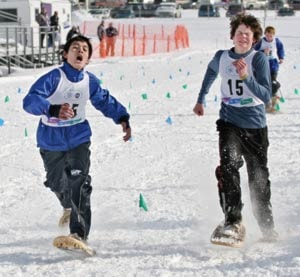Talk about grueling.
After four laps around a soft and punchy 400-metre snow oval at Skyview High School on Monday, most of the snowshoe racers collapsed, panting and completely spent.
It wasn’t the speed that knocked it out of them, but the weight of wet, snow-caked moccasins and traditional wooden snowshoes.
The athletes had already run both a 100- and 400-metre sprint race. The older juniors then did a 1,500-metre and the younger juveniles ran an 800-metre race.
A total score from the three races determines who will stand on the podium as combined snowshoe racing champions.
“It’s fun, but tiring,” said Yukon’s Liam Kiemele, who considers himself more of a skier and cyclist than a snowshoe runner.
“It’s not like skiing; you don’t get to coast on the down hills, and you don’t get that glide, that half-second rest,” he said.
“I’m definitely missing that half-second rest,” he laughed.
It’s a common theme among the other Yukon snowshoers as well.
Junior female Justine Scheck, also a cross-country skier, wanted to try something different after skiing at the Arctic Winter Games in Nuuk, Greenland, in 2002, and in Fort McMurray, Alberta, in 2004.
“I use this as off-season training for track,” said James Yeulet. He said the technique shares very little with regular running however.
“It’s really more of a shuffle; you can lift your legs up, but it would be ineffective.”
It was the Alaskans who dominated this event, finishing first and second in all but the juvenile girls division, which NWT’s Ashtyn McLeod won.
In most of the races, the Alaskans just seemed to have a better technique and more gas in the tank.
“We’re learning a lot; that’s all I can say,” said Yukon snowshoe coach Don White, when asked about his team’s performance.
“We’ve got a lot of new athletes here this time.”
Running in snowshoes requires athletes to learn a new stride.
“It’s not instinctive at all,” said White. “You’ve got to land with a flat foot; if you forget you’re on snowshoes and put your toe down first, you’re down.”
Yukon’s best finish of the day came from juvenile male Yudii Mercredi. He finished second in the 100-metre sprint, but was disqualified for crossing lanes in the 400-metre. After a sixth place in the 800, his combined score was good for fourth place.
Justine Scheck took fourth overall in the junior girls division, finishing third in her 100-metre, and fourth in both the 400- and 1500-metre.
There was a bit of controversy surrounding the races, as many of the athletes were disqualified for crossing into other lanes.
The results are currently under review, although any change in finish order is unlikely.
Later on Monday, the junior mixed team ran a 4x400 relay, with Alaska again taking first and second, and Team Yukon finished fifth.
Team Yukon is looking forward to the longer distance races later this week, hoping to improve on their results.
Junior males will run five- and 10-kilometre races; junior females do five and 7.5 kilometres.
Juvenile males and females will run a 2.5- and a five-kilometre race.
“When it comes to the long-distance stuff, you’ve got a pound and a half of weight on each foot, barring the additional weight when it starts icing up,” said White.
“There’s an awful lot of physical fatigue that happens in the legs, because of all that weight.”
